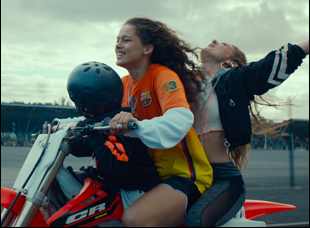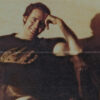“I was born with a bike between my legs,” Julia (Julie Ledru) says rather bluntly before riding off on her motorcycle in “Rodeo,” asserting her place in a largely male world where if not for her gender she wouldn’t be questioned when her skin seems thicker than any of the others in the crew clad in leather. A headstrong heroine led by instinct, she’s not one to be invited into places as much as finding her own way in, making the motorcycle an ideal vehicle to navigate a world in which she feels as if she’s the only one that can stay on top of it.
Fortunately, director Lola Quivoron leaves just enough room on the edge of the seat for one to accompany Julia in her exhilarating feature debut, showing how her lead came by her toughness from her own mother who now refuses to see her and seeks out a family amidst the locals her age who have taken to popping wheelies out on the city thoroughfares as an escape from their lives in the projects. When Quivoron was in film school, she found such a community herself outside her apartment in the suburbs of Paris, a phenomenon she learned wasn’t limited to France as she acknowledged with the title of her 2015 short “Dreaming of Baltimore,” a nod to the dirt bike riders who found empowerment in Lofty Nathan’s 2013 Western Maryland-set doc “12 O’Clock Boys,” but while she could see the strength of a group of outsiders come together to defy their racial and socioeconomic backgrounds, she could still see at least one barrier to entry remaining for a young woman like Julia, counting only five female riders among countless numbers of men.
Upon seeing the fierce Ledru as Julia, there is no question she’d go toe-to-toe with any gearhead that comes her way, but “Rodeo” observes how the character turns perceived weaknesses into strengths, ingratiating herself to the other riders with a scheme scamming unwitting and wealthy Craigslist sellers of their neglected Ducatis by underestimating her and eventually getting herself into the good graces of a mob boss’ wife (Antonia Buresi, the film’s co-writer), who like her, can’t seem to outrun the men in her life even when it’s clear she has all the power. Making savvy use of undulating, uninterrupted takes that allow the world to come alive around Julia in both its undeniable allure and danger, Quivoron doesn’t hold back her own considerable might, making the character study as galvanizing to watch in moments Julia sits in silence as when she’s speeding through the streets.
With its premiere last year at Cannes, “Rodeo” marked the end of a nearly-decade-long journey for Quivoron, who brought back many of the riders she first met seven years earlier to be extras in the feature, but it is clearly only the start for an exciting new auteur and as the film begins to race into American cinemas, she spoke about how the story she wanted to tell changed over time, finding her extraordinarily charismatic lead actress and how she was able to create an environment on set that mirrored the liveliness of the experience she had embedding with the biking community.

Yeah, the two films are really different. “Dreaming of Baltimore” was my first step inside the universe and I began to observe this universe as a photographer at first and then I became a member of the community because I never stopped going to the road where they used to train, observing. I spent seven years with them on several roads, and “Dreaming of Baltimore” was more questioning the social reality of this world and this practice [of motorbiking] and then step by step, every weekend I was with them, chilling, having barbecue and [taking] pictures, I was respected as well as a filmmaker because they loved “Dreaming of Baltimore,” so it was easy for me to write another script, but I wanted the script to focus on the energy and the adrenaline of the rider. It’s like being a junkie, because the rider is always looking for a dose of the adrenaline.
I met a female rider named Bahya, which was really special because it’s really rare, and it was during the summer and I photographed her. She was so special because she had aggressiveness on the road among those 50 [other] riders and she had to fight to create this kind of space and respect and recognition, so I thought maybe I want to write a female character and I didn’t know that it could exist [before] because it was so rare. Then after this summer, she disappeared and it created this big [hole]. So I began to write the character thinking about her as a ghost [because] I was still on the road with the community that I knew and she was not there. But she was still there as this big absence, and I created this female character which is a mix of what I felt [was missing within this community in terms of] female representation but I gave a lot of things [that were stirring] inside me in terms of political aspects and the struggle and the violence.
Then maybe two years before shooting the movie, I met Julie Ledru who plays [this character] Julia and it was a miracle because during the first meeting, when we talked together for the first time, it was like fantasy meeting reality. She had the experience of the female character that I had in mind and I decided to offer her the role, but I adapted it for her. I picked out a lot of anecdotes [she told me] that I put inside the script, and we worked together a lot for her to learn how to play this incandescent, hot-tempered character because Julie, in the real life, has a low energy, so we had to create this kind of intensity, speed, brutality and violence. We had to create all of this package, so we trained a lot together, doing a lot of body exercise and working on the voice prepare the actress, to prepare Julie like a soldier. I chose [to name the character] Julia because before the meeting with Julie, the name of the character was Bahya, the first female rider, but then Julie [became] Julia.

Yeah, Julie Ledru read the script and I think she rediscovered it [doing scenes] with her mother and I told her about the story for many, many, many times, so she had inside her the cognition and accurate picture of the character and of the story. But for the other non-professional actors, it was important for me to give them the mythology of the film [but not the actual script]. We worked together as a collective group before shooting the movie and during these rehearsal sessions, improvising a lot, talking a lot — eating sandwiches again a lot [laughs] — and listening to music as well, we created this bubble of energy, a safe space to create those characters. These were all these scenes outside the script, but connected to the movie and it was a way to work on their character, but not putting a lot of energy to do what I expected to have on the stage, not to break the truth because I wanted the truth to be inside the movie and to really be at the center.
During these rehearsal sessions, I gave them the story as we used to do in the oral tradition, for the mythology, and step by step, month by month, I just expressed the film in several ways, so it created this bigger story [in their mind] with a lot of layers of symbolical meanings. That’s why it was important to [have] this kind of approach, not reading the script, because I gave to them a sense of being independent, and they created their own track to discover the story. But there was this space, which was like a frame to evolve. For the next movie, I think maybe I wouldn’t work in that way because it was really special to this film.

It’s connected to the former question because on the stage, I wanted to follow the characters and as a professional team, we the technicians had to adapt ourselves to them and their energy and the way they move inside the space. For example, the garage sequences were some of the most beautiful sequences I shot because we were gathering inside the space and they were the ones to create a world and we just had to pick up pictures of that. And before that, we had an accident on the set. Unfortunately, Julie twisted her ankle and she had to stop, so we stopped shooting the movie for two weeks. At the beginning, it was difficult to accept that [for both of us] — it was really vital for her and vital for me, and we shared this house together, so we were trying to help each other to find new hope inside this two weeks of pause.
But in this two-week break from the shoot, it was really interesting and helpful for all the riders who stayed inside the hotel because during these two weeks, they created like familial connection and really strong friendships, so when we began shooting again, we started with this sequences inside the garage and it was so moving to see how they created these blood relationships. We just had to shoot it, and I wanted the film to be really a fiction and not so realistic, but surrealistic, but above the reality, playing with the colors and the format of the film, which is the cinemascope format used for the Western. On the other hand, I wanted the film to be free as a documentary, so that’s why I wanted to follow the body as it was a documentary and we had always to adapt ourself to the energy in front of us. It was really funny because we prepared the stage, [all] the lights [and other artifice], but it was the documentary that we used. We were just in this space with these actors playing the scenes and it was catching the energy, the strong energy and the truth of the story.
“Rodeo” is now open in New York at the Angelika Film Center and Chicago at the Music Box Theatre and will expand nationally on March 24th, including the Laemmle Royal in Los Angeles. A full list of theaters and dates is here.




